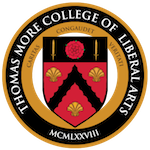Liberal education aims at the production of a certain kind of human being, a man or woman whose soul is characterized by a love for what is noble and whose speech and action are compelling witnesses to the value of a life spent in pursuit of the good. At Thomas More College, even those parts of the curriculum which are devoted to specialized learning have a crucial role to play in integral human formation. The College’s tutorial system provides an opportunity for individual students to shape a portion of their course of studies. The small size of the tutorials provides for careful training in thinking, writing, and speaking, so that students might further hone the abilities they have gained from the common curriculum. Read on to discover more about the tutorials offered this semester!

“Latin Doctors: Medieval Philosophical Theology” with Dr. Patrick Powers
Philosophy, Scripture, and Theology are three of four preeminent intellectual and spiritual sources constituting the TMC curriculum. Among the magisterial thinkers whose works of reflection are our guides to the wisdom of these sources, not only Aristotle and St. Paul, but surely St. Augustine and St. Thomas Aquinas stand out. In our preoccupation with probing the riches of the Confessions and the Summa Theologica, we tend to overlook that these works belong to a rich tradition of philosophical theology stretching over seven hundred years, from the Latin Church Fathers of the fourth and fifth centuries to the Latin Doctors of the eleventh, twelfth, and thirteenth centuries. The College’s tutorials, offered as electives for Juniors and Seniors, fill this gap in the form of “Greek Church Fathers,” which has been offered bi-annually since 2014, and the newly minted “Latin Doctors: Medieval Philosophical Theology,” which is being offered for the first time in spring 2022.
“Latin Doctors” opens with a focus on the emergence of Scholastic thought in the dialogic and meditational works of St. Anselm of Canterbury—namely, Cur Deus Homo and the Proslogion. Then, we listen to St. Albertus Magnus’s commentary on Pseudo Dionysius the Aeropagite’s Mystical Theology. Next, we encounter St. Albert’s student St. Thomas Aquinas in his use of multiple literary forms—among others, allegory, commentary, meditation, sermons, and summa—to fulfill the Dominican charism of preaching and defending the Word of God. The course concludes with St. Bonaventure’s “Mind’s Road to God,” allowing for a comparison and contrast of the two Mendicant Orders that brought the wisdom of the Benedictine Rule from the Monastery into the City.
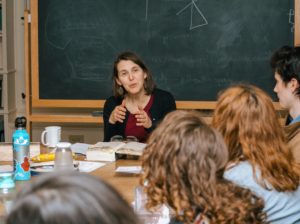 “Across a broken tomb”: The Northern Literature Tutorial with Dr. Amy Fahey
“Across a broken tomb”: The Northern Literature Tutorial with Dr. Amy Fahey
“Do you seek to know more, and what?” So asks the seeress in the haunting verses of the Voluspa (“Prophecy of the Seeress”), that repository of Norse mythology which treats of the trickery of Loki, the power of the one-eyed Odin, the death of the beautiful Baldr, and the destruction of Ragnarok. The students of the Northern Literature tutorial read of the doom of a people best described by Tolkien as relying solely on “self and indomitable will” (the Old Norse term is godlauss—literally, Godless). The course seeks to examine the heathen literature of the pre-Christian north and its formative influence on subsequent Catholic literary giants like J. R. R. Tolkien and Sigrid Undset.
After reading Norse mythology, we next turn to the sagas, including the magisterial Njal’s Saga, in which the consummate Viking hero, Gunnar—who anticipates but does not live to see the conversion of Iceland to Christianity—admits, “What I don’t know is why killing bothers me more than other men.” The great Catholic novelist Sigrid Undset described the experience of reading Njal’s Saga as an “earthquake.” Reading the pre-Christian literature that so deeply influenced Undset, Tolkien, Lewis, and others gives our students a knowledge and appreciation of the way in which these writers identified and transformed the inchoate spiritual longings of the heathens into such masterful fiction.
In another work read in the tutorial, George Mackay Brown’s novel Magnus—an achingly beautiful re-imagining of the life of the twelfth-century Earl and Saint from the Orkney Islands—Bishop William of Orkney writes: “The principal task of the Church in these parts, as I see it, is to reinterpret Fate to those fate-ridden tribes of the north. . . . [T]he actions of men and nations seem to be prompted, rounded, sealed by a sombre inscrutable world-will. Our sagas are obsessed with it. . . . But we who stand at the altars of Christ see history across a broken tomb. Time for us is refreshed with perpetual dewfall and bird-song.”
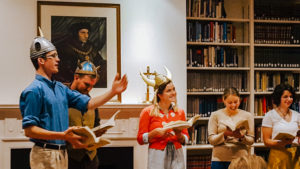
The Northern Literature tutorial is not all doom and gloom: far from it! Students may give presentations on everything from Viking longships to the Runic alphabet; they might be seen reciting Skaldic verse clad in helmet and tunic; they might enjoy class to the accompaniment of smoked salmon and lingonberry jam. But by engaging in such a sustained study of the pagan and Christian writings of the Scandinavian north, our students are able to see how the strengths of the Northern character—their hospitality, boldness, loyalty, and resolve in the face of insurmountable hardship—are aimless without Christ.
The modern Catholic writer confronts a new paganism with a similar but arguably even more challenging task than his medieval Christian forebearers: to reveal to an increasingly post-Christian world what living life “across a broken tomb” actually looks like. It is a task our students have already taken up by committing to four years of study and communal life at Thomas More College, and one which they will embrace with greater urgency as they graduate and enter the public arena.
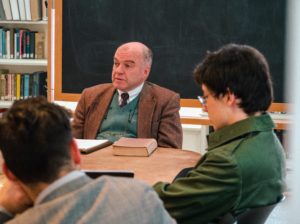 “The Twentieth Century” with Philip Lawler
“The Twentieth Century” with Philip Lawler
When the Dean asked me about tutorial topics I might like to tackle, preferably in the field of the social sciences, I remarked that nearly everyone my age wants to teach a course on the 1960s, a decade that left a deep impression on my generation. I said this mostly as a joke: a comment on the self-absorption that is so common among Baby Boomers. But as I thought it over further, I realized that a course on a broader topic—the whole twentieth century—might have more value.
At Thomas More College, we try to help students understand how their world and their way of thinking has been shaped by influences from the past. In many classes we study the distant past, carefully examining ideas that have stood the test of time. But I thought that a careful look at the more recent past would give young people an opportunity to investigate more proximate influences on their lives. Then, to be candid, I realized that I had another motive for suggesting this course. Too often, I find myself caught up in political debates that I thought had been settled a generation ago. At a minimum, a study of the twentieth century might inoculate students against the influence of ideas that were—or should have been—discredited and discarded.
The twentieth century obviously furnishes a very large field, with more material than we could possibly cover in a semester. My plan is not to concentrate on the historical data (the dates, the battles, the elections), but primarily on the trends that shaped our way of thinking and the debates that, rightly or wrongly, are still unresolved. Anticipating that different students will want to pursue different interests, the last few weeks of the tutorial will be devoted to students’ presentations, giving them a chance to choose and explore their favorite topics.
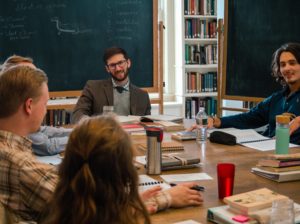 “‘Life’s a Miracle’: Ecology, Wonder, and the Battle for the Meaning of Creation” with Dr. Michael Dominic Taylor
“‘Life’s a Miracle’: Ecology, Wonder, and the Battle for the Meaning of Creation” with Dr. Michael Dominic Taylor
“Life’s a Miracle” is an ecology course in the broadest sense; it is the study of our oikos, our “household,” on many different, yet interconnected levels. The title, taken from King Lear, speaks to the fundamental human need to look at life, our own and that around us, as a miracle and a gift. This awareness brings about the necessary attitudes for both learning and prayer: humility, receptivity, and gratitude. Gloucester’s method of “giving up on life” is not the only one. In his materialism and agnosticism, modern man has found another, far more pervasive and deadening: to perceive reality as asking no questions and containing no mysteries beyond the reach of human reason. By understanding the genesis and prevalence of these ideas, we can better steel ourselves against them and give reason for our hope.
This course also takes inspiration from Thomas Aquinas’s warning to those who, misunderstanding creation, misconstrue the nature of God Himself, the Creator (SCG II.3.1). Recognizing that “The Lord by wisdom founded the earth” (Prov. 3:19 RSV-CE), we approach the science of ecology—studying local flora and fauna as well as the lobster and cod fishing industries—with an eye for the telos of Creation and man’s fundamental role in it. Contemplating Creation through Aquinas’s metaphysics, we discover the entire cosmos as marked by the generosity of the Trinity, revealing that fulfillment is to be found in the gift of oneself.
